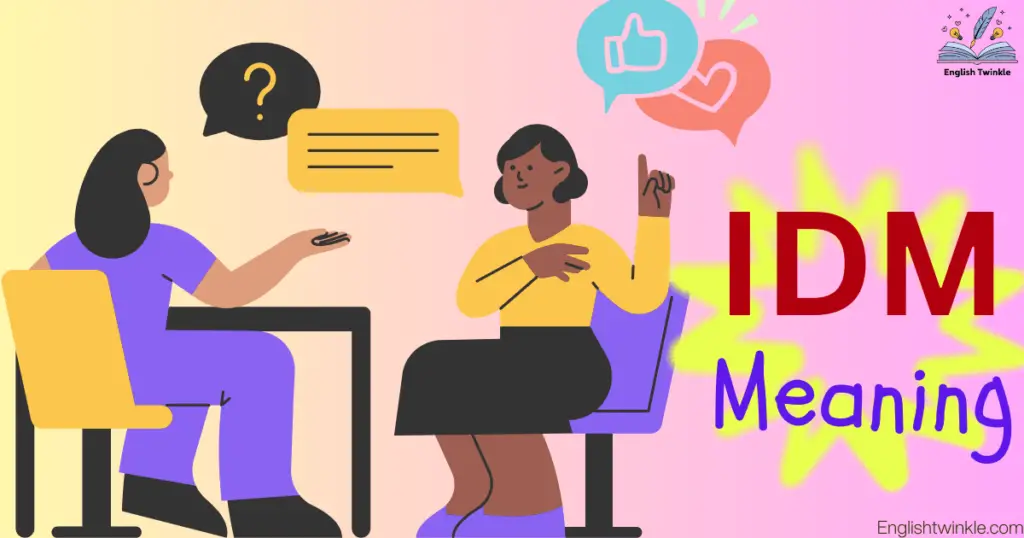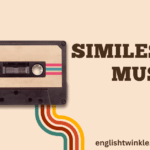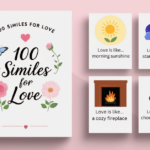In the fast-paced world of texting and social media, new slang terms and acronyms seem to pop up every day. One of these is IDM. If you’ve come across it in a conversation and wondered, “What does IDM mean?” you’re not alone. For many, the term might seem confusing at first glance. However, IDM is simple and widely used in casual digital conversations, especially among younger generations. So, let’s dive in to uncover the meaning of IDM, its usage across platforms like Snapchat, and its popularity.
IDM meaning is mainly a shorthand for “I don’t mind,” a phrase that expresses indifference or neutrality in a friendly way. If someone asks your opinion or preference, replying with “IDM” shows that you’re open to suggestions and don’t have a strong opinion on the matter. This casual response has become a staple in online messaging and helps keep conversations light and flexible.
What Does IDM Mean in Texting?
In texting, IDM is typically used to express indifference. When someone says IDM, they’re letting the other person know that they’re comfortable with whatever decision is made. In other words, they have no particular preference. For example, if someone texts, “Do you want to go out for coffee or stay in?” and you respond with “IDM,” you’re essentially saying, “I’m okay with either choice.”
IDM is popular because it’s short, easy to type, and it keeps things casual. Unlike “IDC,” which stands for “I don’t care” and might sound dismissive, IDM meaning feels softer and friendlier. It’s a subtle way to communicate a relaxed attitude without causing misunderstandings. Acronyms like IDM are particularly popular on platforms where quick responses are common, such as Snapchat and Instagram, where communication often moves at lightning speed.
Examples of Using IDM in Texting
To better understand IDM, let’s look how it’s used in real conversations. Imagine a friend asks, “Want to grab dinner at 6 or 7?” By replying with “IDM,” you’re saying you’re flexible with either time. In another case, if someone asks, “Do you mind if I bring a friend?” responding with “IDM” shows that you’re perfectly okay with their choice.
Here’s another scenario: “Would you prefer a beach day or hiking?” Answering with “IDM” here conveys a willingness to go along with whatever your friend prefers, showing flexibility without sounding uninterested. IDM keeps conversations smooth and makes decision-making a bit easier. It’s also a great way to maintain harmony in group texting conversations.
| Conversation Example | IDM Response |
|---|---|
| “Do you want to meet at noon or 1 pm?” | “IDM, either works!” |
| “Do you mind if we invite Sarah?” | “IDM, that’s fine!” |
| “Would you rather watch a movie or play a game?” | “IDM, up to you!” |
IDM Popularity Over Time
Over time, the use of IDM has grown alongside the rise of texting and social media platforms. With the shift to digital communication, users have found ways to express themselves quickly and effectively, leading to the creation of numerous abbreviations. IDM meaning is part of this trend, making it easy to convey messages without typing full sentences.
As Snapchat, Instagram, and other apps became more popular, so did the need for abbreviations like IDM. It’s worth noting that while IDM is primarily an informal term, it has become widely accepted in digital spaces. This growth reflects a cultural shift toward a more efficient way of communicating, especially among younger generations. Just as “LOL” or “BRB” gained popularity in earlier years, IDM now holds a place in everyday electronic communication.
What Does IDM Mean on Snapchat, Texting, and More?
On Snapchat, IDM has a specific tone. In the app’s casual and fast-paced environment, users often prefer abbreviations to convey messages swiftly. Saying “IDM” on Snapchat might be used in various contexts, such as replying to a suggestion about where to hang out, a plan, or even in response to a question about availability.
Snapchat’s unique messaging style emphasizes brevity, and IDM fits right in with this culture. If you’re familiar with Snapchat, you’ll notice that slang acronyms like “IDC,” “IDK” (I don’t know), and “LMK” (let me know) are commonly used, and IDM aligns perfectly with these. It provides an easy way to agree without sounding overly formal. As an informal reply, IDM helps conversations feel light, casual, and youth-friendly.

Things You Should Know About Using IDM
When using IDM, it’s important to remember that while it’s generally friendly, it might not be appropriate in all settings. For example, in professional or formal settings, IDM could appear too relaxed or even dismissive. It’s best suited for social media, messaging apps, and casual chats with friends or family.
One of the main advantages of IDM is its versatility. While it’s most commonly used to say “I don’t mind,” IDM meanings in different contexts. In the world of electronic music, for example, IDM meaning is Interactive Design Media, a genre of complex and experimental electronic music that blends techno, ambient, and experimental sounds. So if you’re talking to music enthusiasts, be mindful that IDM might have a very different meaning to them.
Steps: What Does IDM Mean on Snapchat?
To fully understand IDM on Snapchat, consider the platform’s unique communication style. Snapchat users, particularly teenagers and young adults, value quick, informal exchanges. IDM fits this environment perfectly, letting users respond with minimal effort while still sounding positive and agreeable. If a friend sends a snap asking, “Wanna meet later?” replying with “IDM” not only shows agreement but also keeps the conversation flowing without any hiccups.
Because Snapchat messages often disappear, brevity and clarity are essential. By using IDM, users can express neutrality or indifference without complicating the conversation. Snapchat also popularized many other slang acronyms due to its focus on brief, real-time interactions, and IDM is one of the simplest ways to signal acceptance or flexibility on the platform.
How to Use IDM in Conversations
Using IDM is straightforward. It works best in casual situations where a choice or decision doesn’t hold significant weight. For instance, if someone asks, “Do you want pizza or burgers for lunch?” and you truly have no preference, IDM shows that you’re okay with whatever choice they make. This acronym can help keep interactions friendly and stress-free, making you appear easygoing and open to options.
It’s essential, however, to avoid overusing IDM. Constantly replying with IDM could give the impression that you’re uninterested in the conversation or lack personal opinions. To keep the conversation lively, try to mix it up by occasionally suggesting your own preferences or asking follow-up questions. This balance helps convey genuine interest while maintaining a relaxed tone.
How to Reply to IDM
When someone replies to you with “IDM,” it’s often an invitation to make the final choice. If a friend says “IDM” in response to a plan or suggestion, it means they’re leaving the decision up to you. A good way to reply to IDM is by confirming the choice or proposing a final plan. For example, if someone responds with IDM when you suggest lunch options, you might reply with, “Great, let’s go with pizza then.”
Alternatively, if you’d like to keep the conversation going, you could ask more questions or make another suggestion. This keeps things interactive and ensures that both sides feel engaged. IDM is a helpful response in texting because it avoids unnecessary back-and-forth while still showing willingness to participate.
When Can You Send IDM?
The best times to use IDM are in casual conversations where you genuinely don’t have a preference. It’s especially effective in group chats or when making plans with friends, as it signals that you’re open to suggestions and don’t want to complicate the decision-making process. IDM can also work well in messaging platforms like Snapchat and Instagram.
However, IDM may not be appropriate in more serious conversations or when a specific answer is expected. For instance, if someone asks about a detailed preference or opinion on a particular matter, replying with IDM might come across as disengaged. Always consider the context before using IDM, as different situations may call for more detailed responses.
Alternate Meanings for IDM
While IDM is best known in texting for “I don’t mind,” it can carry other meanings too. In electronic music, IDM refers to Intelligent Dance Music, a genre known for its intricate rhythms and experimental sounds. This music genre is often seen as a sophisticated branch of techno and electronic music, drawing in listeners who appreciate complex musical arrangements. IDM in this context is entirely unrelated to texting slang, so be aware of the difference if you’re in a conversation with music fans.
Other meanings may also arise in niche communities or professional settings. For example, IDM can mean “Interactive Design Media” in business, though this is far less common in social media or messaging. Knowing these alternate definitions can be helpful to avoid misunderstandings.
More Slang Acronyms to Know
For anyone new to
digital slang, IDM is just one of many acronyms worth learning.
| Acronym | Meaning |
|---|---|
| IDC | I don’t care |
| IDK | I don’t know |
| LMK | Let me know |
| IMO | In my opinion |
| TFW | That feeling when |
Learning these terms can enhance your understanding of online conversations, helping you to keep up with the fast-paced world of internet slang.
IDM: A Quick Guide
In summary, IDM is a friendly, casual way to express indifference or neutrality. However, it’s also important to consider the context. While IDM is great for casual chats, it’s best to avoid it in formal settings or serious discussions. Additionally, be mindful of IDM’s alternate meaning in the world of electronic music, where it stands for Intelligent Dance Music.
The rise of IDM reflects how we’re constantly finding new ways to simplify communication, making it quick and easy to stay connected in a digital world. Whether you’re using it on Snapchat or texting with friends, IDM is a great tool to keep conversations light and easy. So next time someone asks you a question, feel free to reply with IDM if you’re feeling flexible!

Source
Here are five reliable sources that delve into the meaning of “IDM” in various contexts, especially in texting and social media:
- Merriam-Webster explains the meaning of “IDM” as “I don’t mind,” a common abbreviation in online messaging that conveys flexibility or indifference when presented with options. This can be especially useful in casual conversation, as it signals a willingness to go along with the other person’s preference.
- Slang.net provides a quick reference for “IDM,” detailing its usage in texts and social media as a shorthand for “I don’t mind.” It highlights that “IDM” is used to save time and promote smooth conversations.
- Fossbytes expands on “IDM” as an abbreviation used primarily to communicate flexibility. The article notes that “IDM” allows users to convey messages concisely, providing specific examples from everyday situations like deciding where to eat or what movie to watch.
- Urban Dictionary gives a comprehensive view of the acronym’s origins and usage in slang, often in the context of expressing casual indifference. It’s a useful reference for informal definitions that evolve in online communication.
These sources offer a thorough overview of the acronym’s function in digital communication and provide examples that illustrate its flexibility and versatility.








